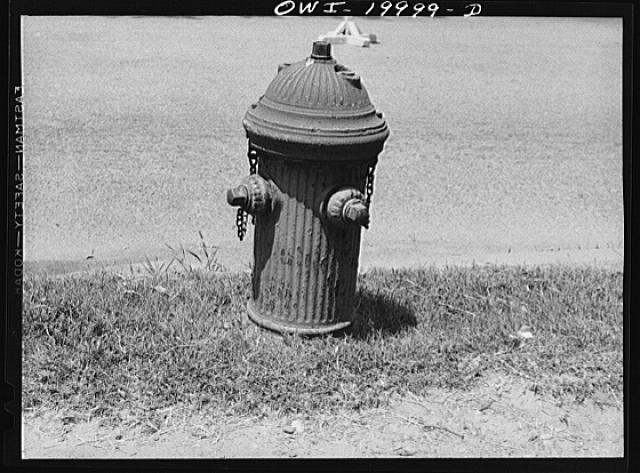A Dog’s Other Best Friend
Donna Reiner has written many articles over the years for the Arizona Republic and others about Phoenix history and memorials. She is a regular contributor to our newsletter. This month, Donna tells us why fire hydrants –something you’d think is about as mundane as buttered white bread– really tell a story about urban growth and how people’s thinking about fire prevention and water use has changed since Phoenix was founded.
Infrastructure is NOT a ho-hum topic. Certainly, it is not a common topic for mealtime discussions, nor probably the old water cooler chats. But imagine, what life would be like if we did not have the infrastructure that we have today?
I recently bumped up against an older form of infrastructure when a septic tank was discovered in my backyard. My subdivision had been platted in 1921 and is located less than a mile north of McDowell Road and Seventh Street, but I couldn’t picture that this area was without sewer hookup at that time (although there was no mention of that in the original ads). And I have no idea if it was ever used. Now it is filled with concrete.
So why is infrastructure so interesting to this historian and other people like me? I’m sure that you can guess that we find the stories associated with it so intriguing. And certainly there are some aha moments.
But now for the story of a dog’s best friend: the ubiquitous fire hydrant! In Phoenix, they are painted a bright yellow and usually found near an intersection. And if you remember the state’s driving codes, you are not supposed to park closer than 15 feet from one. But what is the background on these hydrants?
A laborious search through old newspapers revealed what we might consider to be silly mentions. In 1896, one article cited an order of a fire hydrant for the corner of Fourth and Taylor streets and another indicated a special city council meeting regarding the placement of a hydrant at Van Buren and Third Streets (it was considered urgent business!) And believe it or not, there is still a hydrant on that southeast corner!
The Arizona Republican even posted the expenditures for hydrant rental and repairs. This was important information, but renting hydrants? What was that all about? Further research answered those questions. It seems that the water works system at the time was privately owned and therefore had a contract to furnish a set number of hydrants for a fee, of course. After careful analysis when the contract came up for renewal, the city eventually took over the water system and ended that obligation. Whew….all those behind the scenes discussions which changed the course of our city’s operations.
But imagine, in 1910, every summer night the street department would hose down the dirt streets in the business district using those hydrants in order to keep down the dust! Actually, the department used city jail prisoners to do the hosing all night to complete the task.
But never fear, by 1912, the city was adding hydrants on diagonal corners in the business sector for added protection and also placing hydrants in “remote” residential districts. As the municipal water system expanded and upgraded because Phoenix was growing, more hydrants were added to the system. Interestingly, their placement has for the most part remained constant even with the addition of new hydrants.
If you have a dog, you know how much they love those hydrants. We humans generally take them for granted.


